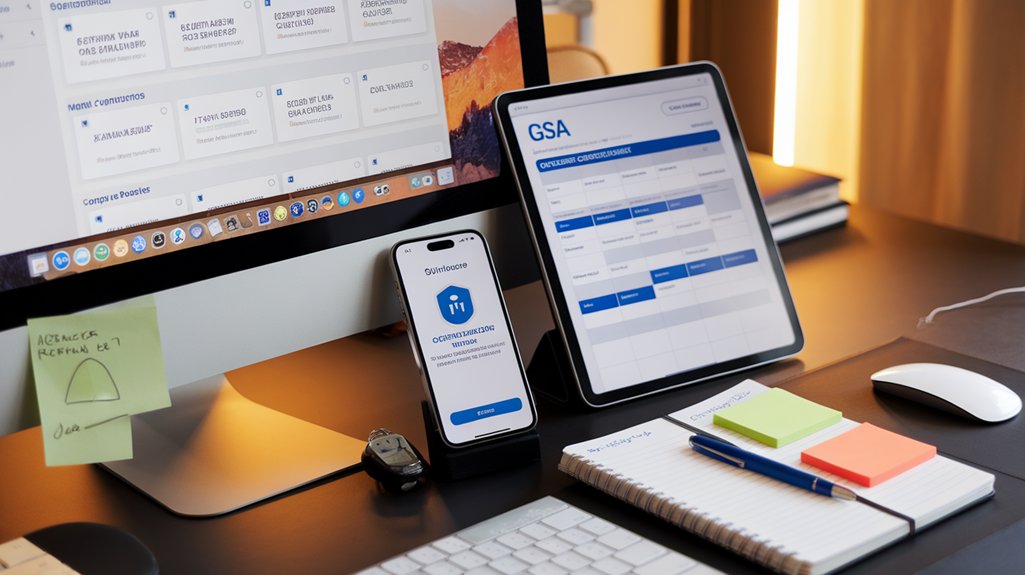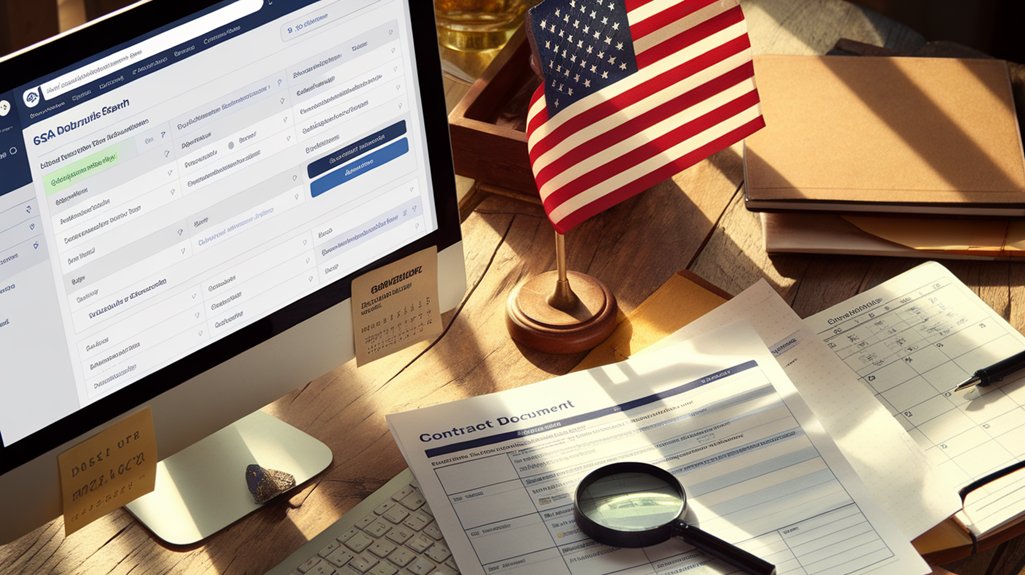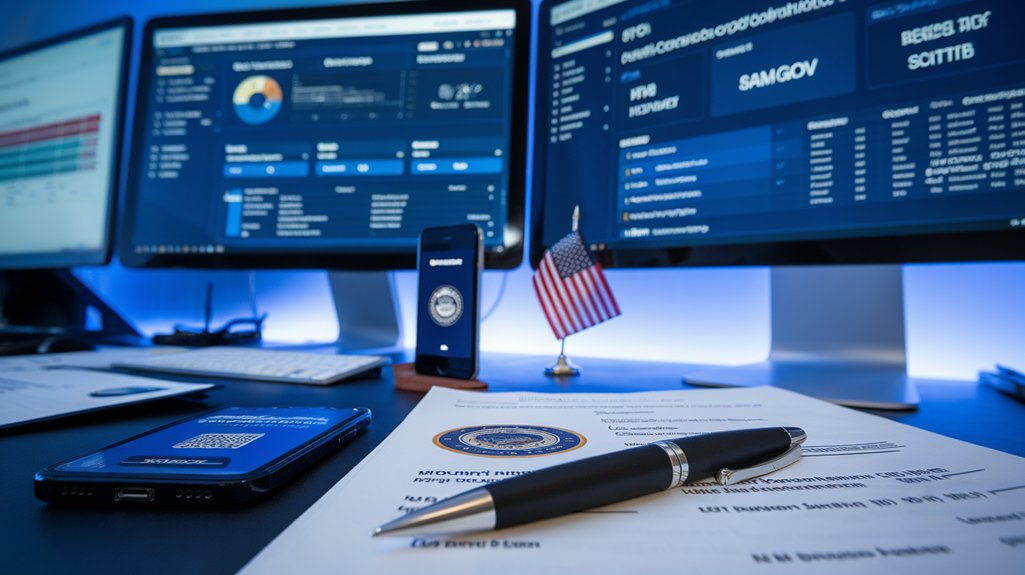Companies seeking GSA Schedule opportunities must first complete their SAM registration to obtain a Unique Entity ID (UEI). After securing SAM credentials, businesses should identify relevant NAICS codes, prepare financial documentation, and develop competitive pricing strategies based on commercial practices. The GSA Schedule application requires submission through the eOffer portal with proper authorization. Annual SAM renewal guarantees continued eligibility for federal contracts. Further exploration reveals targeted strategies for successful contract acquisition.
Essential Steps to Complete Your SAM Registration

Every business seeking federal contracting opportunities must complete a System for Award Management (SAM) registration. This mandatory process establishes your company in the central database used by all federal agencies to identify qualified contractors. A thorough registration checklist helps organize the required documentation before beginning. Understanding the 2025 compliance requirements is crucial to avoid delays in the registration process.
First, obtain your Unique Entity ID, which replaced the DUNS Number system. Your UEI number is a 12-character alphanumeric code essential for government identification. Next, gather your Taxpayer Identification Number (TIN), banking information for electronic funds transfer, and determine applicable NAICS codes for your business services.
The eligibility verification process requires accurate business size designations and ownership details. SAM registration is required for all contracts exceeding $30,000 awarded to foreign vendors operating outside the United States.
To register, create a Login.gov account to access SAM.gov, complete the entity registration with your legal business information, and submit all financial documentation.
After submitting, expect a 10-15 day validation period before your registration becomes active. Remember to schedule annual renewals to maintain contracting eligibility.
Navigating the GSA Schedule Application Process

Securing a GSA Schedule contract begins with a thorough understanding of the Multiple Award Schedule (MAS) program and its application requirements. Vendors must review the GSA solicitation thoroughly, analyzing all terms, pricing requirements, and compliance obligations specific to their chosen Schedule category.
The application process requires meticulous documentation preparation, including financial statements, detailed product or service descriptions, and proof of compliance with federal regulations like the Trade Agreements Act.
Creating a detailed compliance matrix helps vendors cross-reference solicitation clauses with their organizational capabilities, guaranteeing no requirements are overlooked. Vendors should be prepared to demonstrate their past performance to strengthen their application and increase chances of approval.
Successful applications require strategic pricing based on commercial sales practices and market benchmarks. The training provided by Rich Earnest emphasizes developing a compliant and competitive pricing strategy to increase approval chances. All submissions must be completed through the GSA’s eOffer portal with properly formatted documents and authorized electronic signatures.
Before submitting your GSA Schedule application, ensure your business has an active registration in the System for Award Management (SAM) to maintain eligibility for federal contracting opportunities.
After submission, vendors should remain responsive to contracting officer inquiries, which typically require responses within 24-48 hours. This preparation guarantees a smoother path through the complex GSA Schedule application process.
Strategies for Winning Federal Contracts After Registration

Successfully maneuvering the federal marketplace requires contractors to implement targeted strategies after obtaining their GSA Schedule registration.
With federal contract awards reaching $773.68 billion in FY24, businesses must develop competitive approaches to capture their share of this considerable market.
Effective winning strategies begin with smart proposal development, ensuring all compliance requirements are met while highlighting innovative solutions.
Companies should leverage market intelligence to assess opportunities and competitors, developing price-to-win strategies that balance competitiveness with profitability.
Building strategic partnerships through joint ventures and subcontracting relationships can greatly enhance competitive positioning, especially for small businesses seeking set-aside contracts.
Organizations should complete their SAM registration early as it serves as a mandatory prerequisite for accessing government grants and contract opportunities.
Unlike the federal level, state and local opportunities present unique challenges due to fragmented procurement systems that require specialized tracking and response capabilities.
Contractors should also:
- Focus on high-priority areas like IT modernization and cybersecurity
- Participate in industry events to build valuable networks
- Monitor DOGE initiatives that may streamline procurement processes
- Develop a diverse supply chain to improve market positioning
Frequently Asked Questions
How Long Does a SAM Registration Typically Remain Valid?
A SAM registration typically remains valid for one year from the date of approval.
Organizations must engage in the manual renewal process before the expiration to maintain an active status in the federal procurement system.
Maintaining SAM registration requires initiating the renewal at least 60 days before expiration to avoid potential lapses.
This annual process guarantees businesses keep their information current and maintain eligibility for federal contracting opportunities without interruption.
Can International Businesses Register on SAM for GSA Opportunities?
Yes, international businesses can register on SAM for GSA opportunities.
International registration requires obtaining a DUNS number, NCAGE code, and Unique Entity ID before completing the SAM profile.
Foreign entities must submit a notarized letter confirming authorization of the registrant.
Once registered, these companies gain GSA eligibility, allowing them to bid on U.S. government contracts and access procurement opportunities.
The process typically takes 10 business days for approval.
What Costs Are Associated With Maintaining a GSA Schedule Contract?
Maintaining a GSA schedule contract involves several ongoing expenses.
Companies must budget $15,000-$30,000 annually for maintenance fees, which cover pricing updates and compliance requirements.
The quarterly Industrial Funding Fee equals 0.25% of all GSA sales.
Additional costs include contract renewal preparation, modification submissions, and potential consultant fees for regulatory assistance.
Organizations should also allocate resources for training staff on GSA protocols and maintaining proper documentation for potential audits.
Are Subcontractors Required to Have SAM Registration?
Subcontractors are not required to have SAM registration when working under a prime contractor on federal contracts.
However, subcontractor requirements change if they intend to conduct direct business with the federal government. In such cases, SAM registration becomes mandatory.
Prime contractors bear responsibility for verifying their subcontractors’ eligibility, though they typically handle most administrative requirements.
For best practices, subcontractors should consider voluntary registration to increase visibility and prepare for potential direct contracting opportunities.
How Does a Company’s NAICS Code Affect GSA Schedule Eligibility?
A company’s NAICS classifications directly determine its GSA eligibility by connecting business offerings to specific Special Item Numbers (SINs).
Each GSA Schedule category requires alignment with particular NAICS codes that define size standards and eligibility for small business set-asides.
Companies must register appropriate NAICS codes in SAM.gov to access matching SINs on GSA Schedules.
Incorrect NAICS selection can prevent businesses from competing for otherwise suitable contract opportunities and socioeconomic program benefits.